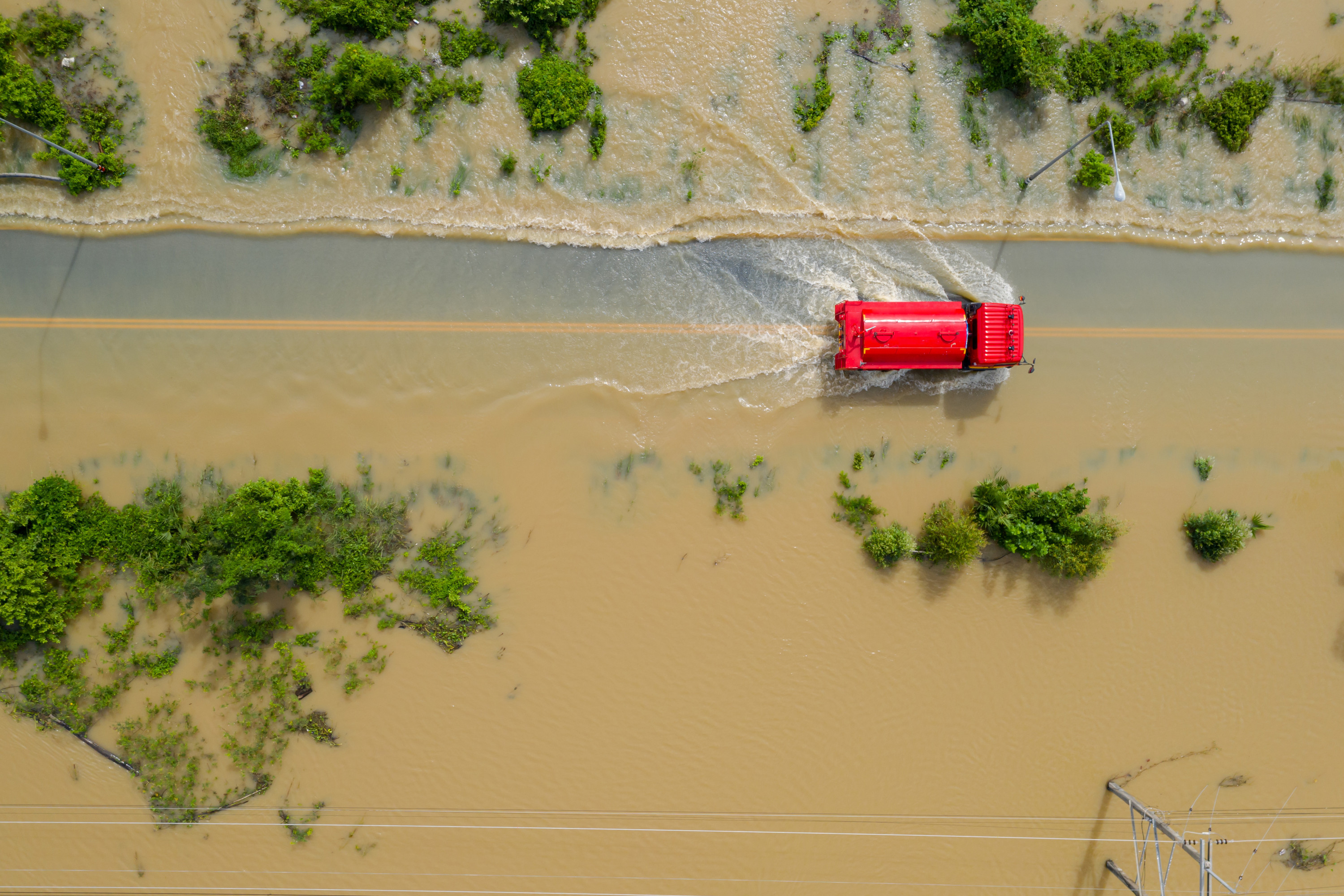New research reveals USD5.6 trillion water risk by 2050
Research exploring the economic consequences of water risk fueled by climate change through to 2050 predicts that droughts, floods and storms could wipe USD5.6 trillion USD from the GDP of key economies, with some more affected than others. Which places and industrial sectors face the most pain, and which are poised to adapt? More importantly, how can we build greater resilience to reduce the impacts of water risk to protect economies and the communities they support?

Projecting water risk
In 2021 droughts, floods and storms affected more than 100 million people globally, causing injury, loss of life and threatened livelihoods. As climate change intensifies, worsening storms are expected to cause increasing losses, estimated at USD1988bn by 2050, with floods and droughts adding USD1472bn and USD607bn additional risk respectively. Aquanomics uses a bespoke model to estimate future water impacts, applying it to eight countries and five critical sectors of the economy. This is the first time that water risk was calculated at a GDP and sector level. Aquanomics found that water risk is spread unevenly, depending on the state of an area’s existing infrastructure, local geographic features, dominant industries, local prevention systems, and existing government policies towards mitigation.
The majority of countries examined in the study have large, technologically advanced economies, with resources that, if deployed swiftly, may reduce these projected costs. Knowing that risk is spread unevenly within these regions may also imply that nations with smaller economies and fewer technology options will face a similar scale of risk, with greater challenges in achieving resilience.
The findings raise an urgent call for investment, innovation and cooperation across regional and national boundaries, presenting opportunities to transform both local and global water systems. This would reduce the economic consequences predicted by Aquanomics, protecting communities and people from ecological impacts and loss of livelihood.
Which places and sectors face the most risk?
In terms of water-related GDP losses between 2022 and 2050, it is estimated that the US will be hit hardest, with estimated losses of USD3719bn. As a percentage of GDP, Australia and the Philippines are also at high risk, with average annual economic declines of between 0.6% and 0.7%.
The UAE is expected to be less affected, with projected losses of USD27bn and a 0.1% average annual GDP loss to 2050 while the UK also faces a similarly small loss of 0.1%.
As for sectors, the Aquanomics research predicts the manufacturing and distribution sector will be most heavily affected by increasing water risk, facing total output losses of USD4211bn by 2050 due to restricted production processes, damaged assets and disrupted distribution. Energy and utilities are expected be least affected, with total projected output losses of USD237bn.
- Philippines
-
$47bn loss by 20500.7% of GDP lost annually (average)
- Australia
-
$393bn loss by 20500.5% of GDP lost annually (average)
- US
-
$4549bn loss by 20500.5% of GDP lost annually (average)
- Canada
-
$128bn loss by 20500.2% of GDP lost annually (average)
- China
-
$1408bn loss by 20500.2% of GDP lost annually (average)
- UAE
-
$33bn loss by 20500.1% of GDP lost annually (average)
- UK
-
$138bn loss by 20500.1% of GDP lost annually (average)
Data shown is average annual % GDP loss between 2022 and 2050 by country
- Manufacturing & distributions
-
$5218BN
- FMCG & retail
-
$1372BN
- Banking & insurance
-
$640BN
- Agriculture
-
$416BN
- Energy & utilities
-
$291BN
Aquanomics’ geographic risk profiles illustrate strengths and vulnerabilities in each country, helping identify where investment in targeted interventions can most effectively mitigate projected impacts.
China, for example, has made huge investments in water infrastructure. These may lessen the human costs of flood events, but the country’s manufacturing and distribution sector could still lose nearly USD1.7tn to shortages and water-related disasters over the next 30 years. Losses could be further reduced by diverting recycled water into these sectors, or by relocating some industries away from flood risk.
Though the UK’s projected financial losses due to water risk are lower, its long coastline and ageing infrastructure are vulnerable to floods that will cost USD153bn between 2022 and 2030 alone. Rehabilitating or replacing water infrastructure may require instituting water harvesting in communities to reduce pumping, or changing utilities’ billing systems to accurately price non-essential uses of water. Increasingly, solutions will require cooperating with nature--in the Medmerry Managed Realignment scheme, for example, the government purchased land from people in endangered communities, relocating residents inland, creating nature reserves and allowing salt marshes to re-establish on the shorelines.
Even the UAE, which has highly advanced water infrastructure, must address a vulnerability to rising sea levels, which could affect critical desalination facilities.
Building water resilience
The diversity of water risk means there is no one-size-fits-all solution for improving resilience to water risk. Adaptation and mitigation efforts in regions facing severe water scarcity will differ from those applied in areas where the greatest risk is posed by over-abundance through flooding and storm events.
In the past, the common response to water challenges was to “build big” — creating centralised systems scaled-up to as much as five times the size of current needs, and intended to perform the same way for over a century.
But building for resilience means we can no longer rely on implementing costly, large-scale and single purpose infrastructure interventions. Governments, businesses, communities and the water sector must take a more strategic view of resource management, focusing on three synergistic principles:
-
Adaptation – build resilience into new projects
The industry needs to rapidly adapt to evolving risk. Adopting an adaptive management model using smaller and even temporary investments--with 5, 10- and 20-year horizons--will allow more flexibility in responding to change. By acknowledging the uncertainty of future challenges, a more integrated and systems-based approach is needed to constantly assess the changing environment, responding in a way that optimises both investment and outcomes for communities and economies.
-
Optimisation – improve and re-purpose the resilience and performance of existing infrastructure with advanced technologies and data driven insights
Improving the responsiveness of water systems can potentially be a game changer. Smart devices and sensors allow utilities to monitor assets in real-time, enabling as-required and predictive operational interventions and maintenance such as managing in real time as floods occur. This saves money by deferring new investment, and informs decisions about directing and adapting future investment. For sectors such as agriculture, irrigation practices based on intelligent asset management can reduce the water needed for production as well as reduce waste in storage and transport of water resources. This is crucial in the world’s thirstiest industry, as food production accounts for almost 70% of global water withdrawals.
-
Prioritisation of regeneration and use of nature-based solutions through adoption of a circular economy
A circular economy approach to water management is crucial. Focusing on water recycling and working with natural processes will improve the long-term sustainability of water infrastructure and reduce costs. Benefits for communities and customers may include more reliable service, higher confidence in local supply chains, swifter recovery from water-related disasters and continued ability to affordably insure homes and businesses.
New projects are beginning to mimic the natural water cycle. Australia will soon build a billion-dollar wastewater treatment plant in Upper South Creek, Sydney, implementing circular economy initiatives to recycle water for urban and industrial uses. Across the world in California, Google has committed to reaching a target of net positive water for its next Silicon Valley campuses.
Circularity may be especially effective in cities, where reused water can be repurposed after recycling to nearby urban greening projects, urban agriculture or into supporting decarbonisation and the energy transition by use in cooling systems or even in green hydrogen production. Or increasingly, returned to the drinking water system itself.
Completing circular reuse of water in this way can eliminate the need to pump water long distances, an expensive process that comes with a high energy — and therefore a high carbon cost. Strategic planning can determine the most opportune and economically beneficial uses for recycled water, which will face high demand as scarcity forces us to diversify water sources.
How we respond to increasing water risk is going to be critical to our future health, prosperity and quality of life. Acting to transform our water systems is not something we can delay or take on in isolation; collaborative action must be taken today. Embracing this reality will help avert the forecast hard economic losses – setting us up for a healthier, more prosperous, and more resilient water future.


